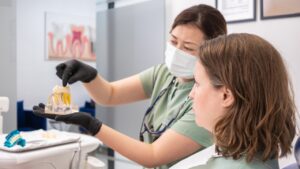Dental Emergency Situations
Understanding and recognizing dental emergencies can be crucial for timely and effective care, especially when dealing with issues like a broken tooth. Here’s what we need to know about dental emergencies.
Understanding Dental Emergencies
Dental emergencies encompass a variety of situations that require immediate attention from a dental professional. These incidents can range from common occurrences, such as a broken tooth, to more severe conditions, like intense tooth pain or infections that may need same-day emergency care. Immediate care is crucial as it helps prevent further damage and can save the affected tooth (McCarthy Dentistry).
Common causes of dental emergencies include:
- Sports-Related Injuries: Contact sports are a frequent cause of dental injuries, leading to cracked or broken teeth.
- Accidental Falls: Falls can result in significant oral injuries.
- Eating: Biting down on hard food items can lead to a sudden tooth breakage.
Signs of Dental Emergencies
Recognizing the signs of dental emergencies can help us take appropriate action swiftly. Some of the common indicators include:
- Severe Toothache: Persistent and intense pain often signals a dental emergency.
- Fractured or Broken Tooth: A visible break, chip, or crack in the tooth, especially if accompanied by pain or bleeding, necessitates immediate care.
- Bleeding Gums or Mouth: Uncontrolled bleeding from the gums or the mouth requires urgent attention.
- Swollen Face or Gums: Swelling can indicate an infection or other serious issue that needs prompt examination and treatment.
- Loose or Knocked-Out Tooth: A tooth that is loose or has been completely knocked out is a dental emergency (Somerville Dentist).
- Signs of Infection: Fever, foul taste, or swelling may signify an infection that needs immediate care. Learn more about the symptoms and treatments for emergency tooth infections.
| Dental Emergency | Immediate Action Required |
|---|---|
| Severe Toothache | Yes |
| Fractured/Broken Tooth | Yes |
| Bleeding Gums/Mouth | Yes |
| Swollen Face/Gums | Yes |
| Loose/Knocked-Out Tooth | Yes |
| Signs of Infection | Yes |
Understanding these signs and taking swift action ensures that we can manage the situation effectively until professional help is available. For more specific guidance, visit our page on what to do if you need same-day emergency dental care.
Handling a Cracked Tooth
Handling a cracked tooth promptly and effectively can prevent further complications and alleviate discomfort.
Causes of Cracked Teeth
Cracked teeth can occur due to various reasons:
- Incidents like a fall or blow to the mouth
- Chronic conditions such as nighttime teeth grinding
- Tooth decay and large dental fillings
- Root canal treatment, which can make teeth more susceptible to fractures
According to Delta Dental, these factors increase the likelihood of experiencing a cracked tooth.
Symptoms of a Cracked Tooth
Identifying the symptoms of a cracked tooth is crucial for timely management. Common indicators include:
- Sensitivity to temperature changes
- Pain while biting down or chewing
- Swelling around the affected tooth
These symptoms could lead to further issues if not addressed. Cracked teeth can result in tooth abscesses, allowing bacteria to infect the tooth pulp.
Home Care for a Cracked Tooth
Proper home care can relieve pain and prevent further damage while waiting for a professional evaluation. Here are some practical tips:
- Rinse with Warm Salt Water: Gently rinse your mouth with warm salt water to reduce swelling and prevent infection. Avoid using mouthwash that contains alcohol.
- Apply Pressure and Cold Compress: If the cracked tooth is bleeding, apply gentle pressure with clean gauze or a soft cloth. To reduce inflammation, apply a cold compress to your cheek for 10-minute intervals.
- Use Over-the-Counter Pain Relievers: Medications like ibuprofen can help alleviate pain and swelling. Avoid chewing on the affected tooth and stick to soft foods to prevent further damage (Pine Grove Family Dental).
- Protect the Tooth: Protect the cracked tooth by applying dental wax or sugar-free gum to cover rough edges, preventing cuts to the tongue or cheeks. If possible, save any broken pieces and bring them to your dentist.
For more information on managing dental emergencies, read our guide on managing dental pain until you can see a dentist. If you experience persistent pain or signs of infection, it’s essential to contact a dental professional as soon as possible. Check our resources for what to do if you need same-day emergency dental care and the signs you need emergency dental care right away.
Dealing with a Broken Tooth
Handling a broken tooth promptly is crucial to prevent further complications and ensure a smoother dental repair process. This section will guide you through the importance of immediate care, temporary solutions, and professional treatment options.
Importance of Immediate Care
When a tooth breaks, it is essential to seek an appointment with a dental professional promptly. Avoid chewing on the affected side and take over-the-counter pain relievers, such as ibuprofen, to minimize discomfort and reduce swelling (Pine Grove Family Dental). Immediate care is important because delaying treatment can lead to more serious complications.
Here are key reasons to prioritize immediate care:
- Preventing further damage
- Reducing pain and swelling
- Minimizing infection risks
- Preserving broken tooth pieces
If you notice severe pain, uncontrolled bleeding, or signs of infection like pus or fever, contact an emergency dentist immediately (Pine Grove Family Dental). Explore our page on signs you need emergency dental care right away for more information.
Temporary Solutions for a Broken Tooth
While waiting for your dental appointment, there are several temporary measures you can take to protect your tooth and alleviate discomfort:
- Rinse Your Mouth: Use warm salt water to clean the area and help reduce pain.
- Apply Dental Wax or Sugar-Free Gum: Cover rough edges to prevent cutting your tongue or cheeks (Pine Grove Family Dental).
- Avoid Chewing on the Affected Side: Stick to soft foods to prevent further damage (McCarthy Dentistry).
- Take Pain Relievers: Over-the-counter options like ibuprofen can help manage pain and swelling.
- Preserve Broken Pieces: Save any fragments of the tooth and bring them to your appointment (Pine Grove Family Dental).
For more tips on managing pain, visit our page on managing dental pain until you can see a dentist.
Professional Treatment Options
Professional dental treatment is necessary to address a broken tooth effectively. The options include:
| Treatment Option | Description |
|---|---|
| Dental Bonding | Applying a resin to the tooth for minor chips and breaks. |
| Dental Crown | Placing a custom-made crown over the tooth to restore its shape and function. |
| Root Canal | Removing damaged or infected pulp within the tooth, then sealing it. |
| Veneers | Placing porcelain layers to cover the front surface of the tooth. |
| Extraction | Removing the tooth when it’s beyond repair. |
An emergency dentist can provide these treatments to restore your tooth and alleviate pain. They can assess the damage and recommend the most suitable treatment to preserve your oral health. For detailed insights on professional care, visit our page on how emergency dentists treat tooth pain fast.
Proper care and immediate action are vital when dealing with a broken tooth. By following these guidelines and seeking prompt professional help, you can ensure the best possible outcome for your dental health. For more information on what to do if you need help immediately, visit our page on what to do if you need same-day emergency dental care.
Seeking Emergency Dental Care
When to Contact an Emergency Dentist
A dental emergency can be unpredictable, often occurring at inconvenient times such as the middle of the night, weekends, or holidays. It’s crucial to contact an emergency dentist immediately if experiencing a dental crisis, such as a broken tooth, especially when the tooth is fractured or cracked. Immediate action is vital to prevent further damage and increase the chances of saving the tooth (McCarthy Dentistry).
Patients should seek immediate medical care if experiencing specific symptoms or signs of infection, and closely monitor any changes in health, contacting the emergency number provided by their dental office for assistance (Somerville Dentist).
Some signs to contact an emergency dentist include:
- Severe tooth pain persisting for days
- A portion of the tooth breaking off
- A knocked-out tooth
Dental Emergency Services Available
In emergency situations, many dental offices dedicate part of their operating hours to attend to patients in need. Patients can receive dental treatment for a broken tooth even if they do not have a regular dentist (Somerville Dentist).
Typical emergency dental services include:
| Service | Description |
|---|---|
| Tooth Pain Management | Immediate relief and treatment for severe tooth pain [how emergency dentists treat tooth pain fast] |
| Tooth Repair | Fixing broken, fractured, or knocked-out teeth |
| Infection Treatment | Addressing dental infections and providing antibiotics [emergency tooth infections: symptoms and treatment options] |
| Pediatric Emergency Care | Same-day emergency care for children and teens [same-day emergency care for kids and teens] |
Steps to Take Before Dental Visit
Taking the correct steps before seeing a dentist can help mitigate damage and ease discomfort. Here are some recommended actions:
- Control Bleeding: Apply gentle pressure with a clean cloth or gauze if there is bleeding.
- Manage Pain: Use over-the-counter pain relievers, but avoid placing aspirin directly on the tooth or gums.
- Protect the Broken Tooth: Use dental wax or sugar-free gum to cover any sharp edges.
- Keep the Area Clean: Rinse the mouth with warm water to clear away debris and reduce the risk of infection.
- Collect Broken Pieces: If a part of the tooth is broken, store it in milk or saliva to preserve it for possible reattachment.
Following these steps can safeguard the tooth and relieve pain until professional care is available. For more tips, visit our article on managing dental pain until you can see a dentist.
When dealing with a broken tooth, it is critical to act promptly and visit an emergency dentist to prevent further complications. For additional information on dental emergency services, check what to do if you need same-day emergency dental care or the benefits of choosing a local emergency dental clinic.
Risks of Not Addressing Broken Teeth
Understanding the risks associated with not addressing a broken tooth promptly is crucial. Let’s explore the potential consequences and impacts.
Potential Consequences of Delay
Delaying treatment for a broken tooth can lead to a number of serious consequences. One of the primary concerns is the risk of infection. When a tooth is broken or severely decayed, bacteria can quickly multiply, leading to painful and dangerous infections if extraction or professional treatment is delayed.
Infections that start in a broken tooth can spread to other parts of the body, potentially leading to more severe health issues. Early recognition of these risks is crucial to avoid complications in the future. For more details, visit our guide on managing dental pain until you can see a dentist.
Impact on Surrounding Teeth
A broken tooth doesn’t just affect the damaged tooth itself; it can also impact the surrounding teeth. An infection in a broken or decayed tooth can spread to neighboring teeth, causing them to become loose and drawing them further into the problem. This can complicate the existing issue and potentially require more extensive treatment if left untreated.
Additionally, the misalignment and constant pressure from a broken tooth can cause wear and tear on adjacent teeth, weakening their structure and making them more susceptible to fractures and decay.
Health Risks of Ignoring Broken Teeth
Ignoring a broken tooth can also pose significant health risks. The infection can progress to form an abscess, a pocket of pus that forms in the bone around the tooth. This condition is not only extremely painful but can also be life-threatening if the infection spreads to other parts of the body.
| Risk | Potential Consequence |
|---|---|
| Infection | Spread to other parts of the body |
| Abscess Formation | Pain and potential for systemic infection |
| Neighbored Teeth Impact | Loosening and additional dental interventions |
By addressing a broken tooth promptly with professional care, such as the services available at our Baltimore Emergency Dental clinic, you can prevent these serious complications. We recommend contacting an emergency dentist for any signs that you need immediate care. For more information, see our articles on signs you need emergency dental care right away and what to do if you need same-day emergency dental care.
Understanding these risks highlights the importance of taking immediate action. Ignoring a broken tooth not only affects your dental health but can also have a cascading impact on your overall well-being. Whether you’re experiencing pain or simply have concerns about a broken tooth, prompt intervention is key. For comprehensive solutions and treatment options, read our sections on how emergency dentists treat tooth pain fast and emergency tooth infections: symptoms and treatment options.
Importance of Prompt Dental Treatment
When dealing with dental emergencies such as a broken tooth, it is crucial to seek prompt dental treatment. Immediate care helps prevent complications and ensures long-term dental health.
Benefits of Early Intervention
Early intervention by a dental professional can significantly enhance the prognosis of a broken tooth.
- Early recognition of risks is crucial to avoid complications, such as infection and further dental damage (Indian Trail Dental Studio).
- Immediate steps to protect the tooth and overall health include avoiding infection and minimizing pain and sensitivity before a dentist’s evaluation (Verywell Health).
| Benefit | Description |
|---|---|
| Infection Prevention | Reduces the risk of bacteria entering the tooth pulp and causing an abscess. |
| Pain Management | Early treatment helps manage and alleviate pain effectively. |
| Preventing Further Damage | Stops the crack from worsening, which can lead to more severe issues. |
Check out our article on how emergency dentists treat tooth pain fast for more tips.
Preventing Further Complications
Addressing a broken tooth promptly can prevent further complications.
- An injured tooth causing pain should be attended to by a dentist promptly to avoid worsening pain and damage.
- Broken teeth are more susceptible to infection, which can spread to surrounding tissues and even into the bloodstream, potentially causing severe health issues (McCarthy Dentistry).
Explore more on how to take immediate action in our post managing dental pain until you can see a dentist.
Long-Term Dental Health
Seeking prompt dental treatment for a broken tooth is essential for maintaining long-term oral health.
- Early treatment can prevent deterioration of the affected tooth and surrounding teeth, thereby preserving overall oral health.
- Addressing issues swiftly reduces the need for more complex and costly dental procedures in the future.
For more information on the benefits of early intervention and the importance of addressing dental emergencies swiftly, read our guide on the benefits of choosing a local emergency dental clinic.
Providing timely care not only resolves the immediate issue but also ensures that we maintain healthy and functional teeth in the long run. Seek professional help immediately to protect your dental health and avoid unnecessary complications.








